

How to promote mental health as a Change Leader. COVID-19 has presented its own array of unique challenges.
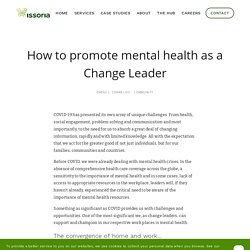
From health, social engagement, problem solving and communication and most importantly, to the need for us to absorb a great deal of changing information, rapidly and with limited knowledge. All with the expectation that we act for the greater good of not just individuals, but for our families, communities and countries. Before COVID, we were already dealing with mental health crises. In the absence of comprehensive health care coverage across the globe, a sensitivity to the importance of mental health and in some cases, lack of access to appropriate resources in the workplace, leaders will, if they haven't already, experienced the critical need to be aware of the importance of mental health resources.
Something as significant as COVID provides us with challenges and opportunities. Turn on, tune in... burn out? Work Has Changed Forever Whatever politicians might say about sandwich shop economics and the billions they have injected into the old economy to stave off redundancies (and boost electoral capital), the question of whether working life can ever return to pre-pandemic normality has already been definitively answered by businesses world-wide.
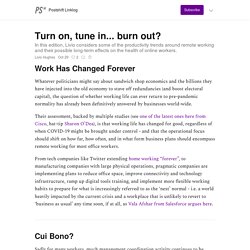
Their assessment, backed by multiple studies (see one of the latest ones here from Cisco, hat-tip Sharon O’Dea), is that working life has changed for good, regardless of when COVID-19 might be brought under control - and that the operational focus should shift on how far, how often, and in what form business plans should encompass remote working for most office workers. Cui Bono? Sadly for many workers, much management coordination activity continues to be focussed on replicating pre-existing processes, methods and rituals, but using digital tools. The result?
Creating a resilient and optimistic workplace. Motivation in Organisations: Searching for a Meaningful Work-Life Balance (11 November 2020) by Manuel Guillen. How organizations can build healthy employee habits. July 6, 2020The COVID-19 pandemic has accelerated many forces already in play over the last decade.
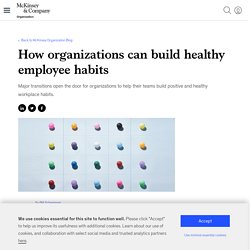
One of the most significant shifts being the move to remote and distributed work. In this context, a frequent question we hear from leaders is: How do we promote healthy and performance-driving habits across our front-line teams, many of whom are more decentralized than ever before? The good news is that there is no better time to build habits than during times of rapid change. Habits are automatic behaviors that occur in response to a recurring cue in the environment. Environmental cues are the key, but often an overlooked, component of habit formation. Thriving during a pandemic: What moves the needle on organizational health. July 30, 2020An organization’s health – how an organization aligns around a commons vision and strategy, executes with excellence, and renews itself to sustainably achieve performance aspirations – explains up to 50 percent of performance variation across companies.

Healthy organizations outperform their competition at every level, delivering 3x total return to their shareholders. Organizational health is even more critical in times of constant change and extreme uncertainty, when the ability to quickly align, execute, and renew can be the difference between floundering and thriving. To measure the impact of COVID-19 on organizational health, we utilized McKinsey’s Organizational Health Index (OHI), which has been deployed on thousands of companies over the past 15+ years and has 6+ million respondents in its database. The OHI assesses both the effectiveness of company practices and the outcomes they drive to understand what is working well and what needs improvement.
Getting started. We need to rethink the role of wellbeing in the workplace. The coronavirus crisis has concertinaed a decade’s worth of ongoing workplace trends into just a few weeks.
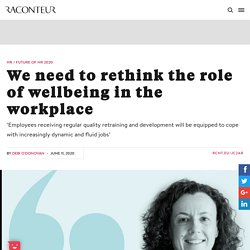
Those in human resources who run employee wellbeing strategies have found their programmes front and centre as they try to help workers to cope, month after month, during the most extreme collective change since the two world wars. Even before the crisis, employers were concerned at how hard organisational change was hitting employees’ wellbeing. The Reward & Employee Benefits Association (REBA)/AXA PPP Employee Wellbeing Research 2020, to be published this month, found that the share of employers citing organisational change as a risk to wellbeing increased 235 per cent between 2019 and 2020, with more than half of employers (57 per cent) identifying it as an issue.
Report - Next Practices in Holistic Well-Being: The Performance Advantage. Next Practices in Holistic Well-Being: The Performance Advantage The COVID-19 pandemic is exacting incredible costs on business continuity, productivity, and organizational survival.
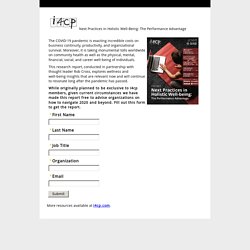
Moreover, it is taking monumental tolls worldwide on community health as well as the physical, mental, financial, social, and career well-being of individuals. Ensuring the wellbeing of your remote workforce. One of the biggest workplace shifts brought about by the COVID-19 pandemic has been that, overnight, most office-based employees have gone from doing an occasional bit of remote working to having to operate exclusively - and indefinitely - from home.
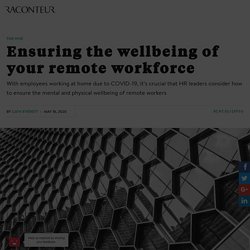
Unsurprisingly then, feelings of a lack of choice over the situation combined with fears over job security and the health threat to family and friends have inevitably led to increased levels of stress and anxiety. As Cary Cooper, president of the Chartered Institute of Personnel and Development and professor of organisational psychology at the Alliance Manchester Business School, notes: “Workplace wellbeing issues, which were already big, are now becoming massive. From an HR perspective, it boils down to how to ensure mental and physical employee wellbeing when all kinds of basic questions about remote working need to be readdressed.”
Physical wellbeing is a further consideration. HR crisis management at its best. Safety: An essential ingredient to your recover strategy. Next Practices in Holistic Well-Being: The Performance Advantage. Checking in on employee health and well-being. The coronavirus has brought many changes to the workplace, and to the relationship between employers and employees.
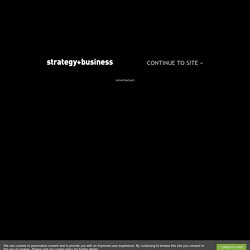
As companies focus on helping their workforce adjust to working from home, they are beginning to understand and overcome the barriers faced in doing so. And they’re having to gather more information — and communicate more regularly — about employees’ health, whereabouts, and movements. In this new normal, companies will need to use technology to keep in touch with their workforces and understand their ability to stay productive and healthy whether they are working at home or at the office.
In a PwC survey conducted during the week of April 20, 37 percent of CFOs around the world said they believe they will see a loss of productivity over the next month due to remote work. In a survey two weeks earlier, 45 percent of respondents anticipated this issue. What Makes an Office Building “Healthy” In a typical year you will take two million breaths in your office.
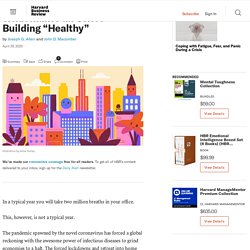
This, however, is not a typical year. The pandemic spawned by the novel coronavirus has forced a global reckoning with the awesome power of infectious diseases to grind economies to a halt. Psychologist: Here's how employers can support mental health. White Noise or Fright Noise? Interpreting the Office. What's the Difference Between Happiness and Wellbeing? How to create a mentally-healthy workplace. “The idea of promoting good mental health applies to everyone in the workplace, not just the people who are struggling.”

So says mental health campaigner and activist, Rob Stephenson, and it is a point of view which cuts right to the heart of the issue of workplace mental health. “When it comes to workplace wellbeing, budgets usually go towards helping those who are suffering- which is morally the right thing to do - but I think it is just as important to focus on a move towards the thriving end of the mental health continuum.”
Indeed, mental health schemes which prioritise prevention can see a much higher return on investment (ROI) than those which only step in once a serious issue has been flagged. Realizing the positive ROI of supporting employees’ mental health. Un plan directeur pour les programmes de santé mentale en milieu de travail. Podcast: How to Create a Positive Work Environment. In this podcast episode, DecisionWise Sr. Consultant and Executive Coach, Dan Deka, discusses the topic of how to create a positive work environment.
In a business setting, to create a positive experience for your customers, it starts with creating a positive experience for your team, which starts in your head with the way you are thinking. Work & Life Are Not Opposing Forces (LinkedIn Speaker Series) Realizing the positive ROI of supporting employees’ mental health. Attributes of the Organizational Change and Its Influence on Attitudes Toward Organizational Change and Well-Being at Work (2019) How to create happier employees. A version of this article appeared in the Autumn 2019 issue of strategy+business. In recent years, many company leaders have embraced well-being and happiness initiatives as critical to both their employees’ satisfaction and the success of their organization.
They have rolled out a variety of programs designed to encourage people to focus on wellness and avoid the harmful effects of stress. What may have at one time been perceived as a perk is quickly becoming a staple of corporate life. Although few would argue with the notion that companies should do what they can to promote the well-being of their workforce, a question looms: Are these initiatives actually making people happier?
The five frames of performance and health. In Beyond Performance 2.0 (John Wiley & Sons, 2019), McKinsey senior partners Scott Keller and Bill Schaninger draw on their 40-plus years of combined experience, and on the most comprehensive research effort of its kind, to provide a practical and proven “how to” guide for leading successful large-scale change. This article, drawn from the book’s opening chapter, provides an overview of this approach and explains why it works. 2019 Organizational Wellbeing & Talent Insights Report - U.S. Edition. Wellness crisis: why employers must take it seriously. It’s sobering to think that only a cursory look at most organisations’ staff absence figures is all that’s needed to indicate there is a full-blown wellness crisis in the UK.
In 2016, stress, anxiety and mental health issues overtook the traditional cause of sickness absence – muscular-skeletal issues – for the first time, and latest Health and Safety Executive data reveals 15.4 million days are now lost each year to mental rather than physical health problems. Correlations between wellness, engagement and productivity are there for all to see Not only is this shocking in its own right – Capita’s just-published Workplace Wellness Report 2019 also reveals 79 per cent of employees say they have felt stressed in the last year, with 47 per cent admitting it is normal to feel stressed and anxious at work – but the transition to wellness being a predominantly mind rather than body-related condition should be a worrying one for employers.
Navigating to Employee Relationship Transformation. How to create happier employees. Tech for Good: Smoothing disruption, improving well-being. The development and adoption of advanced technologies including smart automation and artificial intelligence has the potential not only to raise productivity and GDP growth but also to improve well-being more broadly, including through healthier life and longevity and more leisure. Alongside such benefits, these technologies also have the potential to reduce disruption and the potentially destabilizing effects on society arising from their adoption.
Tech for Good: Smoothing disruption, improving well-being (PDF–1MB) examines the factors that can help society achieve such benefits and makes a first attempt to calculate the impact of technology adoption on welfare growth beyond GDP. Our modeling suggests that good outcomes for the economy overall and for individual well-being come about when technology adoption is focused on innovation-led growth rather than purely on labor reduction and cost savings through automation.
Part 1 Technology, for better and for worse Part 2 Job security Education. What are the most important organizational health practices? What are the most important organizational health practices? What are the most important organizational health practices? Strategy+business. In the last few years, business leaders have turned their search for creative, innovative talent into something of an arms race.
The link between healthy organizations and finding meaning at work. Your organization’s health: the ultimate competitive edge. August 13, 2018 – by Raha Caramitru and Brooke Weddle. 5 Practical Ways to Support Mental Well-being at Work. Benefits Having a holistic mental well-being strategy that includes prevention, intervention and protection is essential for unlocking a workforce’s true potential. The American Institute of Stress reports that stress is the nation’s top health problem.
This makes sense, as mental capacity is highly valued in the workplace but can also be highly vulnerable. Today’s workplace, with technology, fast-paced growth and decreased resources, can contribute to increased stress. Kate Raworth: A healthy economy should be designed to thrive, not grow - TED talk.